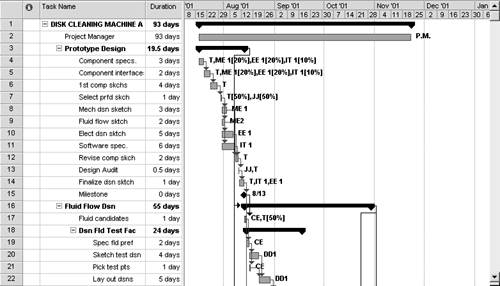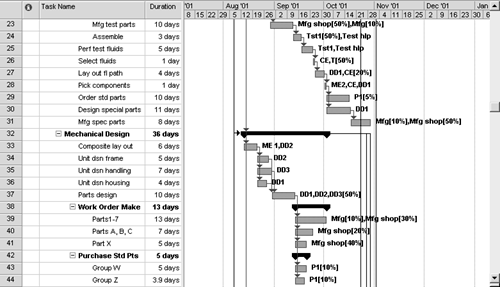| When the work breakdown structure is being disaggregated into major tasks and work packages and it becomes clear that the project team will require more than 30 task leaders, the project is classified as a major project. A major project is too big for the IPM collaborative planning and leadership used for a basic project. However, this does not mean that IPM should be abandoned. Rather, the major project manager should proceed to identify the major tasks or work packages that can each be treated as basic projects within the larger project. Project managers, not task leaders, must be chosen to manage each of these basic projects within the larger project. Each basic project manager will work with the major project manager to create the specification statement, which defines the basic project's objectives. The major project manager will act as the sponsor for each basic project. Each basic project manager will proceed to recruit a team, plan the basic project, and then execute the project's plan. The family of basic projects that the major project manager is responsible for is what classifies this as a major project. The roles played by the major project manager are different from those of a basic project manager. As the major project manager proceeds to develop the work breakdown structure, he or she will identify the work packages within the project that can be treated as separate projects. He or she should attain help from potential basic project managers, subject matter experts, and other persons with experience on similar projects. Often the breakdown of a project is relatively easy. Major projects often break down into a sequence of basic projects. Each basic project delivers an output that serves as the starting point for the next basic project. Some basic projects may run parallel to each other, with the same overlap and slack characteristics that tasks have within a basic project. When each basic project is semi-autonomous, the major project manager's role is that of coordinator. The major project manager does not walk about and micromanage basic project tasks! He or she does, however, stay in close contact with each basic project manager and makes sure that the same communication, which is important in a basic project, occurs among the basic project managers. The major project manager acts as a coordinator and is a key source of support if difficulties do arise. The major project manager collects the project plans of the basic projects as they are developing and consolidates them into a major project Gantt chart. Microsoft Project 2002® has a capacity for large, major projects, but as they grow to include many basic projects, software that has greater capacity, such as Primavera®, is useful. One feature among parallel basic projects that often emerges is an interdependence where a task output within one project is not only necessary for its own project but also is necessary for a task within a parallel basic project. In Chapter 7, a basic project with two critical paths is described. This project not only happens to have two critical paths, but it also is easily divided into two basic projects (see Figure 16-2).
Figure 16-2. 
If the sales work package (Tasks A-D-F-G-H) had 30 tasks or more with 20 separate task leaders, it would have been handled as a basic project that was parallel to a marketing and materials preparation parallel basic project (I-O-V-W-X-CC). Even with the tasks as shown, if each task had required a different task leader, breaking down the project into two basic projects would be reasonable; the two basic projects would proceed in parallel. There are two points where the tasks from the basic "marketing/materials" preparation project provide the necessary inputs for the "sales task" basic project tasks. Task F of the "sales task" project requires an input from Task I of the "marketing/materials preparation" project; and Task G of the "sales task" project needs an input from Task BB of the "marketing/materials preparation" project. The major project manager of this "national marketing and sales" project must ensure that the basic project managers and the team leaders who are most concerned (team leaders I, F, BB, and G) maintain good communication with each other so that the interdependencies would work out smoothly. The "disk cleaning machine" project of Chapter 6 with its Gantt chart also can easily grow into a major project (see Figures 16-3A, 16-3B and 16-3C).
Figure 16-3A. 
Figure 16-3B. 
Figure 16-3C. 
As shown in Figure 16-3A, "prototype Design" could be a basic project. Its project output would be "finalized design sketch," which is the necessary predecessor for the other basic projects that follow it. If the subsequent work packages fluid flow design, mechanical design, software development, and electrical design had many more tasks within them, each would be a basic project. All of these packages lead up to "layout 3D design" (shown in Figure 16-3B) which might be treated as another small basic project that is followed by a string of basic projects of assembly, test, final manufacture and delivery to customer, and installation to complete the major project. This group would be a major project made up of a sequence of basic projects and, a family of parallel basic projects that are included in the sequence. The basic project managers should use IPM principles to plan and execute their projects. The major project manager will act as the sponsor and interproject coordinator for the basic projects. He or she does not micromanage basic projects, but does attend basic project milestone meetings and schedules major project milestone meetings for all of the basic project managers to ensure good intraproject communication and coordination. The actual project refered to here was a very large basic project that could have been handled easily as a major project. It works as a major project because it easily uses two levels of project management. See Figure 16-4.
Figure 16-4. 
|